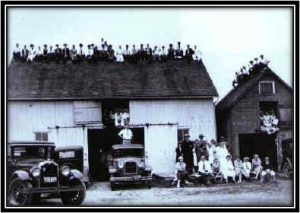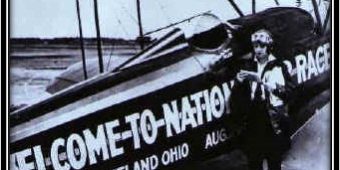The Cleveland National Air Races
Contributor: Barry Fetzer
Sources: Wikipedia, YouTube, Case.edu, Freeola.com
We may never know for certain what might cause us to do what we end up doing, to whom or to what we owe a debt of gratitude for putting us on our path to our life’s pursuits. Or it may be very clear to us.
For me, attending the Cleveland Air Show with my dad at Burke Lakefront Airport as a kid, the successor to the Cleveland (Ohio) National Air Races, played a role in leading me towards aviation. Dad was a former employee (as a newly graduated mechanical engineer in the late 1940’s) of the Cleveland Pneumatic Tool Company, one of the sponsors of the 1929 National Air Races.
The ties that bind.
How about you? What or who led you?
On this date in aviation history, on September 2, 1929, Cleveland, Ohio hosted the first of the National Air Races.

Courtesy Wikipedia.
According to https://case.edu/ech/articles/n/national-air-races, “The National Air Races, begun in 1920 with the first Pulitzer Trophy race, were first held at Cleveland Airport in 1929 and included an aircraft exhibit. There were 35 racing events during the 10-day meet and several cross-country derbies, including what became known as the Powder Puff Derby for women. Aviators Charles Lindbergh, Roscoe Turner, and Amelia Earhart were among those participating in races or aerobatic demonstrations.
“This 1929 meet helped make the National Air Races a major American event, which was important in promoting air travel and advancing aircraft research and development. With the exception of 1930, 1933, 1936, and the war years 1940-45, the races were held in Cleveland until 1949. Two of its most famous events were the Thompson Trophy Race, sponsored by Thompson Products, and the cross-country Bendix Trophy Race, sponsored by the Bendix Corp. Another prominent race was the Louis W. Greve Trophy, named for an important early promoter of the National Air Races from the Cleveland Pneumatic Tool Company family. The Thompson race was a high-speed closed course pylon race, which was barred to women by the mid-1930s because it was believed the race was too dangerous for them to handle competently or safely. During the 1949 Thompson Trophy event, pilot Bill Odom crashed his highly modified P-51C racer into a Berea home, killing himself, resident Jeanne Laird, and her 13-month-old son, Craig. That produced a flurry of ordinances in Berea and other nearby communities to prohibit races over their cities, and there was no national race in 1950; between 1951-63, air shows/races were held elsewhere in the country. A new Cleveland Air Show began in 1964 at Burke Lakefront Airport. Incorporated as the Cleveland National Air Show, it continued the National Air Race tradition without the risk of unlimited-class pylon racing.”
YouTube Video of the 1929 event may be viewed here: https://www.youtube.com/watch?v=N1mzxibhr_8
According to http://www.airracinghistory.freeola.com/Cleveland%20Air%20Races.htm “In 1920, the idea of an Air Show first came to America from Europe when Joseph Pulitzer, publisher of the New York World, put up the money for a race on Long Island’s Mitchell Field. Pulitzer’s goal was to reawaken interested in aviation, which was suffering from post WWI apathy.
“The event circulated to different cities for nine years and was finally brought to Cleveland in 1929 by a group of local businessmen headed by Louis W. Greve and Frederick C. Crawford. Greve was president of the Cleveland Pneumatic Tool Company, which made the hydraulic undercarriages that held the wheels on airplanes. Crawford was general manager and later president of Thompson Products Inc., now a part of TRW Inc. Thompson Products developed the experimental sodium-cooled valves, which enabled Charles Lindbergh’s Spirit of St. Louis to reach France.
 People watching the Air Show from a local barn. Photo courtesy of freeola.com.
People watching the Air Show from a local barn. Photo courtesy of freeola.com.
“The event was a 10-day sensation setting the highest standard for Air Shows with amazing demonstrations, size, duration and attendance. The inauguration ceremonies opened with a downtown parade that rivalled the Rose Bowl Tournament parade. An estimated 300,000 spectators from all over the country watched 200 floats, 21 bands and 1,500 marchers strut down Euclid Avenue as three Goodyear blimps flew overhead. In conjunction with the Air Show, a $3,000,000 display of planes filled Cleveland’s Public Auditorium, 5,000 pigeons were released on Public Square, and aerial acrobatics and fireworks reigned over head. Over 100,000 spectators attended the opening day of the Air Races.
 Courtesy freeola.com.
Courtesy freeola.com.
“In 1929, airplanes were still considered something of a science fiction fantasy, therefore the exciting flying events were reported in newspapers around the world. The daily flying schedule included ‘dead stick’ landing contests, glider demonstrations, Goodyear blimp flights, parachute jumping contests and military demonstrations. The Navy High Hats, a formation team formed long before the Blue Angels, created a worldwide sensation by flying with their planes tied together by one-inch ropes from wing-struts to wing struts. Even the late Charles A. Lindbergh was in the show flying a Boeing biplane. There were also closed-course pylon races and cross-country races from as far away as Log Angeles, Miami and Toronto; all timed to reach Cleveland on different days of the show. Women pilots, including the already famous Amelia Earhart, raced in a special ‘Powder Puff Derby’ from Santa Monica, California, to Cleveland.
“But it was the closed-course racing that provided the most thrills for the fans in the stands. The Thompson Race, the first free-for-all closed-course race, was five laps around a 10-mile circuit.
“‘Smiling’ Doug Davis, a civilian pilot from Atlanta won the race with an average speed of 194.9 miles per hour. The Thompson Trophy based on the Greek Legend of Icarus who melted his feathered wings by flying too close to the sun, became equal in stature to the Green Jacket of the Masters Golf Tournament. In turn the world’s top aviators competed for the right to keep it for a year.”
Onward and upward!
Credits: Wikipedia, YouTube, Case.edu, freeola.com







